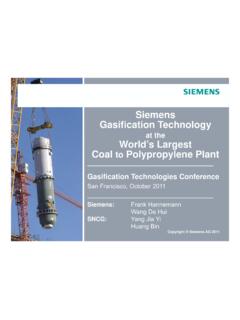Transcription of Coal Gasification - Encyclopedia of Life Support Systems
1 COAL, OIL SHALE, NATURAL BITUMEN, HEAVY OIL AND PEAT Vol. I - Coal Gasification - Xingzhong Sha COAL Gasification . Xingzhong Sha Department of Energy Sources Chemical technology , Shanghai, China Keywords: Agglomerating Ash Gasifier, Applications of Coal Gasification , Ash Zone, BGC-L Gasifier, Classification of Coal Gasification , Coal Char Gasification Reaction, Coal Char's Reactivity, Coal Combustion, Coal Gasification , Coal Gasification Thermodynamics, Coal Indirect Liquifaction, Coal Pyrolysis, Coal Slurry, Combustion Zone, Destec Gasifier, Devolatilization Zone, Dry and Fine Coal Feed, Dry Ash Gasifier, Dry and Lump Coal Feed, Drying Zone, Entrained Bed Gasifier, Fisher- Tropsch (F-T) Process, Fluidized Bed Gasifier, Fuel Gas, Gasification Kinetics, Gasification Zone, Gas Turbine, Hydrocracking, Hydrogasification, High-heat-content Gas, HTW Gasifier, IGCC, KRW Gasifier, K-T Gasifier, Low-heat-content Gas, Lurgi Gasifier, Medium-heat-content Gas, Molten Bath Bed Gasifier, Moving Bed Gasifier, S.
2 TE S. Prenflo Gasifier, SCGP, Slagging Ash Gasifier, Steam Turbine, Synthesis Gas, TCGP, R. AP LS. Two-stage Gasifier, U-Gas Gasifier, Wellman-Galusha Gasifier, Winkler Gasifier Contents C EO. 1. Introduction 2. Chemistry of Coal Gasification Rapid Devolatilization and Hydrogasification Coal Gasification Reactions E . H. Thermodynamics Coal Char Gasification Kinetics PL O. Coal Char Hydrogen Reaction M SC. Coal Char Carbon Dioxide Reaction Coal Char Steam Reaction Some Factors Related to Char's Reactivity 3. Coal Gasification Processes SA NE. Moving Bed Coal Gasification Processes Wellman Galusha Process Lurgi Process U. BGC-L Gasifier Fluidized Bed Coal Gasification Winkler Process High Temperature Winkler Process (HTW Process). U-gas Process and KRW Gasification Process Entrained Bed Gasification Processes Koppers Totzck Process (K-T).
3 Shell-Koppers, PRENFLO, and SCGP. Texaco Coal Gasification Process (TCGP). Destec (Dow) Coal Gasification technology 4. Applications of Coal Gasification 5. Conclusion Glossary Bibliography Encyclopedia of Life Support Systems (EOLSS). COAL, OIL SHALE, NATURAL BITUMEN, HEAVY OIL AND PEAT Vol. I - Coal Gasification - Xingzhong Sha Biographical Sketch Summary Coal Gasification is one of the clean coal technologies. The purposes to convert coal into coal gas are stated in this article. The emphasis is put on integrated coal Gasification combined cycle as one of the applications of coal Gasification because of its higher efficiency and the greatest potential for meeting stringent emission control requirements. Coal Gasification reactions, thermodynamics, and kinetics of Gasification reactions are presented in brief.
4 After coal Gasification processes are divided into several categories, 4 types of coal Gasification processes are demonstrated respectively, these are moving bed, fluidized bed, entrained bed, and molten bed. Some typical or advanced gasifiers introduced are restricted to these in commercial operation and those in large size pilot plant. They are Lurgi gasifier and BGC-L gasifier for the moving bed process, Winkler gasifier, HTW gasifier and U-Gas or KRW gasifier for the fluidized S. TE S. bed process, and the K-T gasifier, Prenflo, SCGP, TCGP and Dow gasifier for the R. AP LS. entrained bed process. These gasifiers are discussed according to their methods for feeding coal and ash removal, principal operating conditions, Gasification efficiency, and other process characteristics.
5 C EO. 1. Introduction Coal Gasification , just as the term suggests, means that coal can be gasified into gas, which is then largely used as fuel gas or chemical feedstock, and sometimes used as E . industrial reducing gas, in other words coal can be converted into a more easily utilized H. gaseous form. The technology to convert coal into gas is hardly new and coal PL O. Gasification has been developed and abandoned periodically during the past two centuries. Fuel gas was first produced commercially from coal in the early nineteenth M SC. century. In 1839 the first fixed-grate producer was introduced. In 1852 cyclic operation to produce water gas was invented. During 1900 1920 the mechanical producer was developed which in a sense had already reached its present form.
6 The synthesis of SA NE. ammonia and methanol from water gas grew strongly during 1920s. After the Second World War cheaper natural gas and oil displaced coal gas from many of its former user in the world except in South Africa and some developing countries. In response to the U. first oil crisis in 1973 the altered price and availability relationship between oil and coal increased a strong incentive in coal Gasification technology , therefore, a lot of coal Gasification processes had been developed. Some processes developed are quite successful; these processes are called the second-generation technology of coal Gasification . Why should coal be gasified? One reason for coal Gasification is to make up the shortage in liquid and gaseous fuels. Now the world economy depends on energy provided principally by oil and natural gas, but in the twenty-first century world petroleum and natural gas production will begin to decline because of increasing world population and aspirations for an improvement in the quality of life.
7 Therefore the need for a transition to other energy sources is necessary. Coal is an abundantly available energy source and coal Gasification is a primary way to produce liquid fuels for transportation and gaseous fuels for heating and chemical production. Some Encyclopedia of Life Support Systems (EOLSS). COAL, OIL SHALE, NATURAL BITUMEN, HEAVY OIL AND PEAT Vol. I - Coal Gasification - Xingzhong Sha technologies for producing liquid fuels and gaseous fuels have been commercialized for quite some years and some are still under development. In many cases these technologies are available, obstacles for commercial application have been the high cost. Another reason for coal Gasification is necessity to develop advanced power generation system. The world electric utility industry has greatly depended on the relative abundance of coal.
8 Clearly, the expanded use of coal is still vital to future electrical power generation and the expanded use of coal must be carried out in an environmentally acceptable and economically competitive manner. For conventional pulverized coal fired power plants, it is difficult to meet these requirements. As an advanced power generation system, integrated coal Gasification combined cycle (IGCC). offers an attractive approach to produce electrical power at high efficiency and has shown the greatest potential for meeting stringent emission control requirements. Therefore coal Gasification is a very important clean coal technology from the viewpoint of sustainable development. We should pay attention to coal Gasification technology and its applicable technologies.
9 S. TE S. R. AP LS. Coal gas is a mixture of gases. This mixture is usually made up of carbon monoxide (CO), hydrogen (H2), carbon dioxide (CO2), nitrogen (N2), and varying amounts of methane (CH4). Coal gas is classified by heating value. Low-heat-content (also termed low-Btu) gas has a heating value below 7 MJ m-3 and is mainly a mixture of nitrogen C EO. and carbon dioxide, with the combustible components, carbon monoxide, hydrogen, and methane. High-heat-content (or high Btu) gas has a heating value about 37MJ m-3. and consists mainly of methane. The gas is also called substitute or synthetic natural gas or SNG. Medium-heat-content (or medium Btu) gas has a heating value between 7 and E . 15 MJ m-3. Gas at the lower end of this range consists of carbon monoxide and H.
10 Hydrogen, while gas at the higher end contains more methane. PL O. M SC. SA NE. U. Figure1. Coal Gasification process Encyclopedia of Life Support Systems (EOLSS). COAL, OIL SHALE, NATURAL BITUMEN, HEAVY OIL AND PEAT Vol. I - Coal Gasification - Xingzhong Sha The production of each of these gases is shown in Figure 1. Coal is first crushed and sometimes dried, then fed into gasifier, in which coal reacts with steam and either air or oxygen. The Gasification reaction usually occurs at high temperatures from 800 to 1900 C and high pressure up to 10 MPa. When coal is burned with less than a stoichiometric quantity of air, with or without steam, the product is low- heat-content gas, which after purification can be used as fuel gas. Utilizing oxygen in place of air produces medium-heat-content gas.















